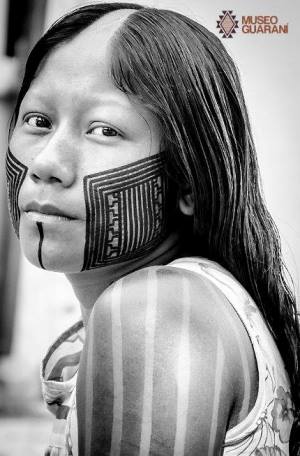|
Guarani Culture: Guarani Museum The Guarani Museum (Museo Guaraní) of Santa Cruz, Bolivia houses about 150 pieces recovered from areas of Bolivia inhabited by native Guaraní peoples.

The Guaraní and Tupi Guarani continue to preserve their culture, traditions and customs and use their language, but these are all in danger of disappearing as more and more Guaraní people migrate to cities in search of work. Their land is being overtaken and their population suffers from malnutrition and various diseases that are reducing their numbers. The Guarani culture vanquished the Chané tribes that inhabited their region during colonial times and assimilated them (when they talk of being "mestizo" or "criolle") they are referring to a Guaraní-Chané mix. They were eventually enslaved by the Spanish and forced to work on large haciendas. The Guarani museum was built after several years of research in an attempt to make foreigners and the general population of Bolivia more aware of the contributions of the Guaraní culture to today's society, and of the importance of ensuring their traditions and way of life are preserved. The Guaraní people wanted a voice of their own with which to tell their story. Today the Guarani are Bolivia's third largest population group, numbering about 108,000. The Guarani language is still widely spoken and is also taught in Universities. At this museum you can see some of the clay pots used to bury the dead, other clay household items, some of the musical instruments used in the "pinguyu" (also known as the "pinguyu yambol") as part of the Arete Guazú, a Guaraní carnaval-type cultural festival. There are also some masks (the winged masks are of the Ancestors and the wooden masks are the "Abuelos", or grandparents). There are also clay pots used to make chicha, a traditional alcoholic drink based on corn, and others for cooking. There are hunting tools like bows and arrows and slings and you'll see woven goods such as hammocks and purses, each with its own unique and different design. You'll also see something quite awful: a long piece of timber with holes in it formerly used by hacienda owners to punish the Guaraní they had enslaved by shackling their wrists, legs or necks in the holes for hours or days at a time. The museum is managed by the Guaraní people themselves and is the only museum in Santa Cruz dedicated specifically to one culture. It is located across the street from the NORTH side of the Santa Cruz Zoo, so why not make a day of it and visit both on the same day. (If you stand facing the Zoo entrance, to get to the Guaraní Museum walk to your right, up the sidewalk to the corner, then left about 1 block). The museum also has a small library and image archive for those interested. Though small, the Guaraní Museum will give you a really good feel for how different the indigenous peoples of Eastern Bolivia are from Andean peoples, which is what most tourists are told about in reference to Bolivia. Bolivia is truly like two completely different countries in one. It is so worth a visit, just to learn a little about the history of these forest and rainforest tribes that are so infrequently mentioned in travel guides and brochures. Av. Marcelo Terceros Banzer #7 3er Anillo Externo Across from (behind) the Santa Cruz Zoo Santa Cruz - Bolivia Tel: +591-3-341-2047 or +591-7-260-0303 www.Facebook.com/MuseoGuarani Admission: Students Bs. 1.00 - Adults Bs. 10.00 Open Monday to Friday 9:00 to 12:00 and 1:00 to 4:00 Open Saturday and Sunday 9:00 to 6:00 Today the Guaraní are divided into three main groups called TCOs: the Ava, the Simba, and the Izoseños (from the Izozog area). This last group is now highly organized into communities, each with its own Capitán. All communities together are presided over by a High Capitán and a Capitán Segundo (second in line). They are working very hard to ensure their people are treated with equality, have pressured the government to designate land to their communities, and are highly involved in other activities to ensure the Guarani culture survives and that their rights are ensured. It is the latter of the three groups (which inhabits the Isosog TCO that borders Kaa-Iya National Park and has formed an organization called the CABI - Capitaní del Alto y Bajo Izozog), that runs the Guarani Museum. I spent several days among the Guarani villages deep in Southeastern Bolivia. They allowed me to take pictures, visit their homes and fields, and watch them make their handcrafts and weavings. Learn more about the Guaraní culture.     |